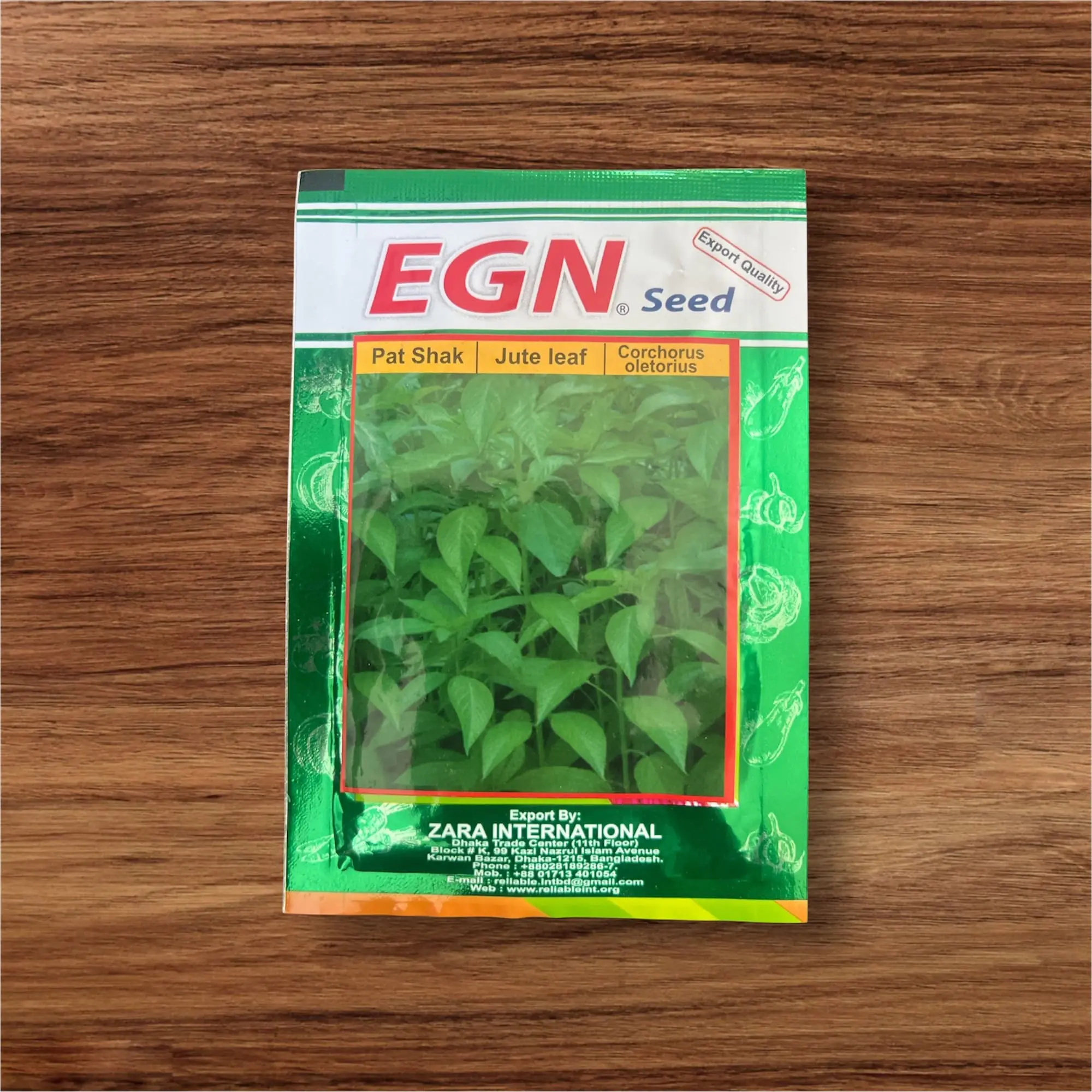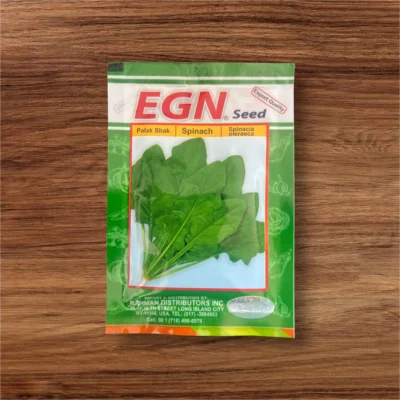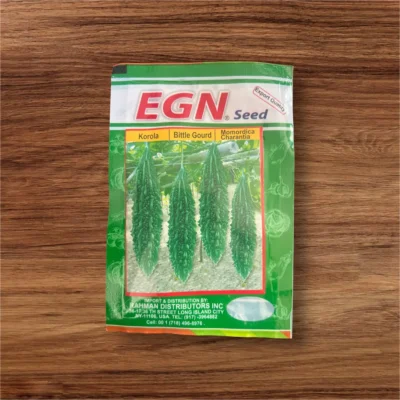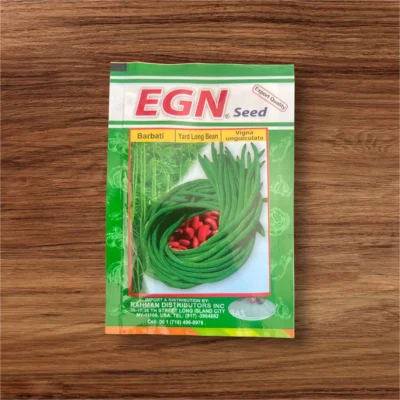Jute Leaf Seeds – Pat Shak Corchorus Olitorius | Egyptian Spinach Seeds
Original price was: $7.00.$4.99Current price is: $4.99.
Grow nutritious Pat Shak (Jute Leaf) with premium Corchorus Olitorius seeds. Superfood greens rich in vitamins. 200-250 seeds per pack. Fast shipping!
100 in stock (can be backordered)
Product Overview
Discover the nutritional powerhouse of Pat Shak with our premium jute leaf seeds, the traditional green leafy vegetable that has nourished South Asian families for centuries. These Corchorus olitorius seeds produce fast-growing plants with tender, mucilaginous leaves packed with vitamins and minerals, a true superfood that’s essential in Bengali cuisine and increasingly popular among health-conscious gardeners worldwide.
Product Details
- Weight: 0.013 lbs (approximately 6 grams)
- Seed Count: Approximately 200-250 premium seeds per package
- Scientific Name: Corchorus olitorius
- Common Names: Pat Shak, Jute Leaf, Egyptian Spinach, Jew’s Mallow, Molokhia, Tossa Jute
- Origin: Sourced from traditional South Asian suppliers
- Germination Rate: 80-90% under optimal conditions
- Organic: Yes, naturally grown without chemical treatments
Why Choose Our Pat Shak Seeds?
Authentic Heritage Variety
Our Pat Shak seeds come from the traditional jute leaf variety that has been cultivated for over 4,000 years in Bangladesh, India, and throughout South Asia. These aren’t commercial fiber jute varieties—they’re specifically selected for optimal leaf production and the characteristic mucilaginous texture that makes Pat Shak unique in traditional cooking.
Nutritional Superfood Properties
Pat Shak leaves are among the most nutrient-dense vegetables available, containing exceptional levels of vitamins A, C, and E, plus significant amounts of calcium, iron, potassium, and antioxidants. The natural mucilage provides digestive benefits and acts as a natural thickening agent in traditional dishes.
Fast-Growing & Heat Tolerant
These vigorous plants grow quickly in warm weather, producing harvestable leaves in just 30-40 days. Pat Shak thrives in hot, humid conditions where other leafy greens struggle, making it perfect for summer gardens and tropical climates.
Growing Your Jute Leaf Plants
Planting Instructions
Best Planting Time: Direct sow after soil temperature reaches 65°F (18°C), or start indoors 2-3 weeks before outdoor planting
Soil Requirements: Well-draining soil with pH 6.0-7.5. Tolerates various soil types but prefers fertile, organic matter-rich conditions
Spacing: Scatter seeds thinly and cover lightly with ¼ inch soil. Thin seedlings to 4-6 inches apart when 2-3 inches tall
Germination: Seeds germinate in 5-10 days under warm, moist conditions
Care & Maintenance
Watering: Maintain consistent soil moisture, especially during germination and early growth. Established plants tolerate some drought
Fertilization: Apply balanced fertilizer every 3-4 weeks. Pat Shak responds well to organic compost and nitrogen-rich amendments
Temperature: Thrives in temperatures between 75-90°F (24-32°C). Growth slows in cooler conditions
Harvesting: Begin picking young leaves when plants reach 6-8 inches tall, continuing throughout the growing season
Harvest & Traditional Uses
Harvesting Guidelines
- First Harvest: Begin picking tender young leaves 30-40 days after planting
- Continuous Harvest: Regular picking encourages new leaf growth throughout season
- Optimal Size: Harvest leaves when 2-4 inches long for best texture and flavor
- Morning Harvest: Pick leaves in early morning for maximum freshness and nutrient retention
Traditional Culinary Applications
Bengali Cuisine: Essential for authentic Pat Shak Bhaji, traditionally cooked with garlic, onions, and mustard oil
Egyptian Cooking: Known as Molokhia, used in traditional soups and stews with chicken or lamb
Middle Eastern Dishes: Popular in Lebanese and Syrian cuisine for its thickening properties in soups
West African Cooking: Widely used in traditional stews and vegetable preparations
Modern Nutritional Uses
- Superfood smoothies and green juices
- Nutrient-dense salads (young tender leaves)
- Natural thickening agent for soups and stews
- Dehydrated leaf powder as nutritional supplement
- Stir-fries and sautéed vegetable medleys
Exceptional Nutritional Profile
Vitamin & Mineral Content
- Vitamin A: Over 6,000 IU per 100g (supports eye health and immunity)
- Vitamin C: High levels for immune system support and iron absorption
- Vitamin E: Powerful antioxidant properties
- Calcium: Essential for bone health (higher than spinach)
- Iron: Critical for blood health and energy production
- Potassium: Supports heart health and blood pressure regulation
Unique Health Benefits
Natural Mucilage: The characteristic slippery texture provides digestive benefits, soothing inflammatory conditions and supporting gut health
Antioxidant Properties: High levels of beta-carotene, flavonoids, and phenolic compounds protect against oxidative stress
Anti-inflammatory Effects: Traditional medicine recognizes Pat Shak for reducing inflammation and supporting joint health
Traditional Medicine Applications
In Ayurvedic and traditional Bengali medicine, Pat Shak is valued for its cooling properties, digestive support, and blood-purifying qualities. It’s commonly recommended for maintaining healthy skin, supporting liver function, and providing natural detoxification.
Growing Tips for Maximum Success
Climate Requirements
Optimal Conditions: Thrives in warm, humid climates similar to Bangladesh and tropical regions
Temperature Range: Grows best between 75-90°F (24-32°C), tolerates up to 100°F (38°C)
Humidity Tolerance: Excellent performance in high humidity conditions where other greens may struggle
Season Length: Requires 60-90 frost-free days for full season production
Soil Preparation
Organic Matter: Incorporate 2-3 inches of compost or well-rotted manure for optimal growth
Drainage: Ensure adequate drainage while maintaining moisture retention
pH Management: Test and adjust soil pH to 6.0-7.5 range for best nutrient uptake
Succession Planting
Continuous Harvest: Plant new seeds every 2-3 weeks for constant supply of tender leaves
Season Extension: In mild climates, continue planting through fall for winter harvests
Indoor Growing: Can be grown indoors or in greenhouses during cooler months
Container & Small Space Growing
Urban Gardening Applications
Container Size: Minimum 6-inch deep containers with good drainage
Spacing: Grows well in dense plantings, perfect for small space gardens
Balcony Growing: Excellent choice for sunny balconies and patios
Microgreen Production: Can be harvested as microgreens for maximum nutrition density
Vertical Growing Systems
- Excellent for living walls and vertical gardens
- Compact growth habit suitable for tower gardens
- Fast growth cycle perfect for hydroponic systems
- Ideal for container stacking systems
Pest Management & Disease Prevention
Natural Pest Resistance
Pat Shak is naturally resistant to most common garden pests due to its mucilaginous properties and rapid growth cycle.
Common Issues:
- Flea Beetles: Use row covers during early growth stages
- Aphids: Encourage beneficial insects or use insecticidal soap
- Fungal Issues: Ensure good air circulation and avoid overhead watering
Organic Management
- Companion planting with marigolds and herbs
- Beneficial insect habitat creation
- Proper spacing for air circulation
- Crop rotation to prevent soil-borne issues
Seed Saving & Sustainability
Saving Seeds for Future Seasons
Flowering: Allow select plants to flower and produce seed pods
Seed Collection: Harvest pods when brown and dry, typically 80-100 days from planting
Processing: Extract small seeds from dried pods and store in cool, dry conditions
Viability: Properly stored seeds remain viable for 3-4 years
Sustainable Growing Practices
- Self-seeding capability in suitable climates
- Nitrogen fixation benefits soil health
- Rapid growth reduces garden space requirements
- Traditional variety preservation
Cultural & Historical Significance
Ancient Heritage
Pat Shak has been cultivated for over 4,000 years, with origins tracing back to ancient Egypt and India. Archaeological evidence shows jute cultivation in the Indus Valley civilization, making it one of humanity’s oldest cultivated vegetables.
Cultural Importance
In Bengali culture, Pat Shak represents resilience and nutrition during challenging times. It’s considered a “poor man’s spinach” that provides superior nutrition and grows easily in difficult conditions, embodying the practical wisdom of traditional agriculture.
Modern Recognition
Contemporary nutritionists recognize Pat Shak as a superfood, leading to increased interest in Western countries among health-conscious consumers and sustainable agriculture advocates.
Seasonal Growing Calendar
Spring Planting (April-May)
- Direct sow when soil warms to 65°F
- Prepare beds with organic amendments
- Begin succession planting schedule
Summer Growing (June-August)
- Peak growing season with optimal conditions
- Continuous harvesting of tender leaves
- Multiple succession plantings
Fall Extension (September-October)
- Continue harvesting until first frost
- Collect seeds from mature plants
- Prepare preserved leaves for winter use
Processing & Preservation Methods
Fresh Storage
Refrigeration: Fresh leaves keep 3-5 days in refrigerator crisper drawer
Washing: Clean thoroughly before storage to remove soil particles
Packaging: Store in perforated plastic bags to maintain humidity while preventing decay
Traditional Preservation
Drying: Sun-dry leaves for long-term storage and winter use
Fermentation: Traditional Bengali methods create preserved Pat Shak preparations
Freezing: Blanch and freeze for year-round availability
Powder: Dehydrate and grind into nutritional powder supplement
Package Contents & Quality Guarantee
What You Receive
- Premium Pat Shak seeds (0.013 lbs package)
Our Promise
We guarantee the authenticity and viability of our jute leaf seeds. These are specifically selected for leaf production, not fiber varieties. If germination rates fall below 75% under proper growing conditions, we’ll provide replacement seeds or full refund within 30 days.
Storage & Seed Longevity
Store seeds in original packaging in cool, dry location away from direct sunlight. Properly stored Pat Shak seeds maintain viability for 3-4 years, with optimal germination when planted within 2 years of packaging date.
Ready to grow this ancient superfood in your garden? Order these premium Pat Shak (Jute Leaf) seeds today and experience the exceptional nutrition and authentic flavors that have sustained South Asian families for millennia. Perfect for traditional cooking, modern health-conscious cuisine, and sustainable gardening practices!
Note: Seeds are for planting purposes only and are intended for leaf production. Growing success varies based on local climate conditions, soil preparation, and proper cultivation practices.
| Weight | 0.013 g |
|---|
Only logged in customers who have purchased this product may leave a review.






Reviews
There are no reviews yet.